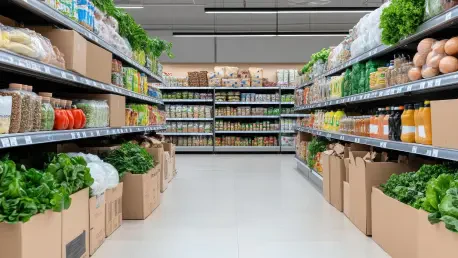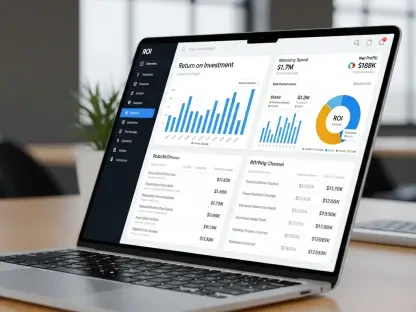Understanding the Grocery Supply Chain Landscape
Current State and Industry Scope
The grocery supply chain stands as a cornerstone of global food security, navigating a complex web of interconnected segments such as manufacturing, warehousing, logistics, retail, and fulfillment. This intricate network ensures that food reaches billions of consumers daily, playing a vital role in sustaining communities and supporting economic stability. With rising populations and urbanization, the pressure on this system to deliver efficiently and reliably has never been greater, especially amidst evolving market demands.
Beyond its operational scope, the industry significantly influences job creation and trade balances across nations. Its ability to adapt to disruptions, whether caused by natural disasters or economic shifts, directly impacts the availability of essential goods. As a result, maintaining a robust supply chain is not just a business concern but a societal imperative, underpinning the resilience of entire economies.
Major Players and Influences
Key stakeholders in the grocery supply chain include multinational retailers, logistics providers, technology firms, and agricultural producers, each shaping the industry’s direction. Technological advancements, such as real-time tracking and data analytics, have redefined operational efficiencies, while market dynamics like globalization continue to expand the reach and complexity of supply networks. These forces collectively drive innovation and competition within the sector.
Consumer expectations, fueled by the demand for convenience and transparency, are pushing companies to integrate digital tools into their operations. Online shopping platforms and mobile applications have become essential, allowing customers to track orders and access product information instantly. This digital shift, while beneficial, places additional strain on traditional supply chain models, necessitating rapid adaptation to stay competitive.
Emerging Trends Shaping the Grocery Supply Chain
Key Drivers and Innovations
Sustainability has emerged as a dominant force, with companies prioritizing eco-friendly practices to reduce carbon footprints and waste across operations. Automation and digitalization are also transforming the landscape, streamlining processes from inventory management to order fulfillment. Additionally, the push for faster last-mile delivery reflects a growing need to meet consumer demands for speed and convenience in an increasingly on-demand market.
Changing consumer behaviors, such as the preference for locally sourced products and personalized shopping experiences, are compelling businesses to rethink supply chain strategies. The rise of e-commerce has further accelerated this shift, requiring flexible logistics solutions to handle fluctuating order volumes. Balancing these expectations with operational efficiency remains a critical focus for industry leaders aiming to maintain customer loyalty.
Growth Projections and Market Insights
Looking ahead, technology adoption is expected to grow significantly from this year through 2027, with investments in automation and artificial intelligence projected to enhance supply chain precision. Sustainability initiatives are also forecasted to gain momentum, as regulations and consumer pressure drive the adoption of greener practices. Market performance is anticipated to strengthen, supported by resilience-building measures that address both current and future disruptions.
Cost optimization efforts are set to play a pivotal role in maintaining profitability amid rising operational expenses. Companies are likely to focus on data-driven decision-making to identify inefficiencies and allocate resources effectively. These strategies, combined with innovative logistics models, are expected to bolster the industry’s ability to navigate economic uncertainties and sustain growth over the coming years.
Critical Challenges Facing the Grocery Supply Chain
Headwinds and Disruptions
Geopolitical tensions and extreme weather events pose substantial risks, disrupting the flow of goods and increasing operational unpredictability. Rising costs, driven by inflation and labor shortages, further complicate the ability to maintain affordable pricing for consumers. These challenges impact every segment, from raw material sourcing in manufacturing to timely delivery in retail, threatening the overall stability of supply networks.
Security threats, including cyberattacks and physical theft, add another layer of complexity, particularly in logistics and warehousing. Such disruptions not only lead to financial losses but also erode consumer trust when delays or shortages occur. Addressing these multifaceted issues requires a comprehensive approach that anticipates risks and minimizes their impact on day-to-day operations.
Strategies to Overcome Obstacles
Embedding risk management into strategic planning is essential for mitigating the impact of disruptions and ensuring continuity. Investments in resilient systems, such as diversified supplier networks and backup inventory solutions, can help cushion the blow of unexpected events. Proactive measures like scenario planning also enable companies to respond swiftly to emerging challenges without compromising service quality.
Collaboration across the supply chain is equally vital, as partnerships between stakeholders can pool resources and expertise to tackle shared problems. Strategic investments in technology and infrastructure further enhance performance by improving visibility and responsiveness. Together, these efforts create a more adaptable framework capable of withstanding both predictable and unforeseen obstacles.
Regulatory and Security Considerations
Compliance and Industry Standards
Regulations surrounding sustainability and food safety are becoming increasingly stringent, requiring strict adherence to emission reduction targets and quality controls. Compliance with these standards is not optional but a fundamental aspect of maintaining market access and consumer confidence. Businesses must navigate a complex landscape of local and international policies to avoid penalties and reputational damage.
The push for sustainable practices extends beyond regulatory mandates, as stakeholders demand transparency in environmental impact reporting. Food safety protocols, meanwhile, ensure that products meet health standards at every stage of the supply chain. Aligning operations with these requirements often involves significant investment but is crucial for long-term credibility and operational success.
Securing the Supply Chain
Protecting against fuel and energy volatility is a pressing concern, as fluctuations can disrupt logistics and inflate costs unexpectedly. Robust security measures, including advanced monitoring systems and contingency plans, are necessary to safeguard critical operations. These efforts help maintain stability in the face of external threats, ensuring that goods move seamlessly from source to shelf.
Building secure systems also involves addressing vulnerabilities in digital infrastructure, where data breaches can compromise sensitive information. Implementing cybersecurity protocols and training staff on best practices are key steps in fortifying the supply chain. By prioritizing both physical and digital security, companies can better protect their assets and maintain trust with partners and customers.
The Future of Grocery Supply Chains
Innovations and Market Disruptors
Emerging technologies like advanced automation and blockchain are poised to revolutionize supply chain transparency and efficiency. Personalized delivery models, tailored to individual consumer preferences, are also gaining traction as a potential game-changer in retail fulfillment. These innovations promise to reshape how goods are sourced, stored, and delivered, setting new benchmarks for performance.
Global economic conditions, coupled with shifting consumer priorities toward sustainability and convenience, will continue to influence strategic planning. Companies must anticipate these changes by adopting flexible frameworks that can pivot as market needs evolve. Staying ahead of disruptors requires a willingness to experiment with novel solutions and integrate them into existing operations.
Opportunities for Growth and Resilience
Sustainable practices offer a significant avenue for innovation, as reducing waste and energy use can drive both cost savings and brand loyalty. Smart technology integration, such as predictive analytics for demand forecasting, further enhances decision-making and operational agility. These advancements position the industry to capitalize on emerging opportunities while addressing longstanding inefficiencies.
Partnerships and bold investments are critical for creating a future-ready supply chain capable of withstanding challenges. Collaborative efforts can accelerate the adoption of best practices and share the burden of innovation costs. By fostering a culture of adaptability and forward-thinking, the industry can build resilience that ensures long-term growth and stability.
Conclusion and Path Forward
Summarizing Key Insights
Reflecting on the analysis, it becomes clear that the grocery supply chain faces unprecedented challenges that demand urgent transformation. The identified trends, including sustainability, technology adoption, and last-mile flexibility, underscore the industry’s direction toward smarter, more adaptable systems. These insights highlight a collective need to prioritize resilience and innovation to meet consumer demands effectively.
Recommendations for Industry Leaders
Looking back, actionable steps emerge as a critical takeaway for stakeholders who seek to navigate future uncertainties. Industry leaders are encouraged to invest strategically in sustainable technologies and forge partnerships that amplify their capacity to innovate. By committing to these initiatives, the path is paved for a secure, customer-focused supply chain that can adapt to evolving global demands with confidence.









